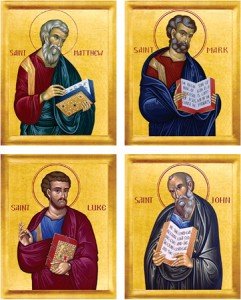 For the past several weeks I have been sharing with my readers what scholars think about the similarities and dissimilarities found in the three Synoptic Gospels. I shared the first theory, Oral Tradition, which suggests that differences are due to various oral traditions. The second theory, Literary Interdependence, puts forth two possibilities, namely that Mark’s Gospel is the source for both Matthew and Luke’s Gospels OR that Matthew is the literary source for the other two Gospels. In the last issue I began sharing yet another theory, namely hypotheses about some one other document being the source of all the Gospels. The first example of this theory is that a single document is the basis for a three-fold tradition. The next theory in this category is that a complementary document is the basis for a twofold tradition. This theory attempts to explain the origin of the material common only to Matthew and Luke. It is called the Two-Document Theory.
For the past several weeks I have been sharing with my readers what scholars think about the similarities and dissimilarities found in the three Synoptic Gospels. I shared the first theory, Oral Tradition, which suggests that differences are due to various oral traditions. The second theory, Literary Interdependence, puts forth two possibilities, namely that Mark’s Gospel is the source for both Matthew and Luke’s Gospels OR that Matthew is the literary source for the other two Gospels. In the last issue I began sharing yet another theory, namely hypotheses about some one other document being the source of all the Gospels. The first example of this theory is that a single document is the basis for a three-fold tradition. The next theory in this category is that a complementary document is the basis for a twofold tradition. This theory attempts to explain the origin of the material common only to Matthew and Luke. It is called the Two-Document Theory.
This hypothesis holds wide acceptance among Protestants and, in a modified form, among Catholics as well. Despite Matthew’s and Luke’s independence of each other, there are agreements in opposition to Mark that seem to call for a Greek source prior to Mark. This Greek source, whose existence is pure conjecture, consisted almost entirely of words or sayings of Jesus. The two later Synoptics, namely Luke and Matthew, would have drawn the greater part of their material from this source plus Mark, adapting the material to the different circles they wishes to reach. It ought to be kept in mind that those who would identify this “Q” document with Aram Matthew “M” or its Greek form “Mg”, in order to defend the “traditional” sequence giving Matthew priority, are thought to do so arbitrarily.
This two-document theory has become very complex through numerous versions and modifications. One of its great unsolved problems is that the phenomena positing the existence of “Q” appear not only in the sayings sections but also in the narrative sections. The “Q” material has always been considered a Greek collection of sayings, not a true narrative. Moreover this classical theory does not take into account oral tradition. The Gospels could not have arisen solely as a writing process.
It is my hope that sharing these various ideas about the Gospels will give my readers a greater appreciation of our Sacred Literature. The Gospels, although based on history, are not historical documents. They are documents written to promote faith.
